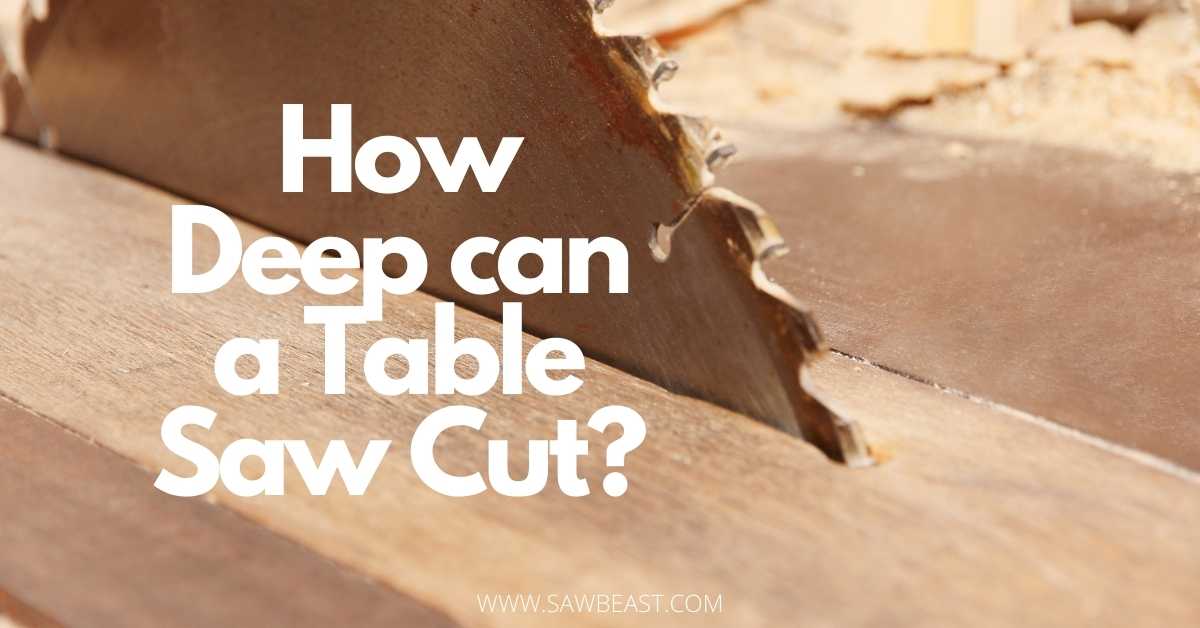If you’re into woodworking, a table saw is a must.
It’s the go-to tool for precise woodcuts and is way more accurate than other options. Perfect for big projects with thick wood, plastic, or glass, a table saw is essential.
It’s versatile too, making angled cuts, rip cuts, and crosscuts, adding efficiency to your work.
However, the question that arises in the mind of every buyer is: How deep can a table saw cut into materials?
Before we answer this question, you need to understand how a table saw actually works.
How Does a Table Saw Work?
The table saw, without its blade, is a simple table standing about 30-35 inches in height, resembling a kitchen stand.
It comes in various sizes and materials, with metals being the most common choice, particularly heavy-duty steel and cast iron.
The table serves as the surface where the workpiece is placed for cutting.
At the center of the table surface is a sharp, circular blade protruding out. This Circular Table Saw Blade performs all the cutting.
In some table saws, the blade is powered by a battery, while in others, an electric motor serves as the power source with an average horsepower of 2-4 HP.
The blade rotates in a circular motion as it cuts deep into the wood.
The depth to which the table saw can cut usually depends on the power of the motor and the length of the blade.
The saw blades also come with a blade cover, providing protection against the blade coming into contact with your flesh and cutting your hands.
Opposite the blade is the rip fence, running parallel to the blade and locking the piece of wood in place.
It acts as a secure guide to ensure the wood piece does not slide off the table, remaining stable and fixed precisely where it needs to be.
This feature helps in making straight and neat cuts.
The distance between the fence and the blade is known as the rip capacity, indicating the maximum width of your cut.
Other notable features in a table saw include a miter gauge, allowing you to make angled and bevel cuts.
The miter gauge can be adjusted anywhere from 0 to 90 degrees, facilitating the creation of desired cuts.
Anti-kickback pawls are also installed to allow you to make any kind of cut while keeping safety in check, ensuring the workpiece does not go flying off due to the fast motion of the blade.
With these features working together as a team, you can make a variety of cuts and create any wood piece you desire.
How Deep Can a Table Saw Cut?
The Depth of Table Saw Cuts depends on the following two factors:
1. Blade Length
There is no fixed depth for a table saw cut as it is directly proportional to the length of the blade. The longer the blade, the deeper the cut will be.
The majority of table saws available in the market use a 10-inch circular blade.
This doesn’t mean the table saw can make 10-inch deep cuts; instead, it refers to the distance between the two extreme points of the circular blade, i.e., its diameter.
As the blade rotates around its center point in a circular motion, only its radius is involved in cutting.
However, the maximum depth of the cut is not equal to the radius because the pivot on which the blade is mounted is below the arbor, the shaft that holds the blade.
This difference further decreases the maximum depth of the cut. Hence, a standard 10-inch blade can make a cut as deep as 3.5 inches.
If you have a larger table saw with a 12-inch blade, the maximum cut you can make is 4 inches.
The table below shows the maximum depth of the cut that can be made with different blade lengths:
| Blade Length | Cutting Depth |
| 4” | 0.75” |
| 5 ½” | 1.5” |
| 7 ¼” | 2.5” |
| 10” | 3.5” |
| 12” | 4” |
2. Blade Adjustability
The length of the table saw blades is not fixed and can be adjusted.
This flexibility allows you to tailor the blade to the type of cut you want to make.
Whether it’s just a few millimeters deep or the maximum depth the blade allows, you have the control.
Even though a table saw with a 10-inch blade can make a 3.5-inch cut, you can adjust it to cut only 1 inch or even a few millimeters into the piece of wood.
This height adjustment is possible by using the crank attached beneath the surface of the table.
Turning this crank in one direction raises the blade height, while in the other direction, it lowers it.
Best Blades for Making Deep Cuts
To fully unleash the potential of your table saw, it’s important to have different types of blades with various sizes in your toolbox.
This ensures that you can perform every type of cut with great efficiency.
For your assistance, we have listed the two must-have blades below:
50-Point General Purpose Blade
This blade serves as an excellent alternative to a 10-inch blade, especially for novice workers not attempting complex cuts, as it is safer to use.
When used in conjunction with a 10-inch blade, it can handle large projects with minimal splintering.
Although it may not cut through very thick materials, it is ideal for everyday use and can efficiently perform rip and crosscuts with its 50 sharp teeth.
8-Inch Stack Dado Kit
It’s always advised to keep an 8-inch blade in your arsenal at all times.
There will be times when you need to perform cuts with great delicacy and precision, and a smaller blade, i.e., an 8-inch blade, proves to be much more effective.
While a 10-inch blade is highly effective, a smaller blade for more precise cuts is always preferred.
Additionally, using these blades stacked together allows you to make thick grooves in materials without cutting all the way through.
Conclusion
There’s no straightforward answer to how deep a table saw can cut. It primarily depends on the type of table saw and the size of the circular blade attached.
The greater the blade diameter, the deeper the maximum cut.
Additionally, the craftsman’s skill in adjusting the blade height plays a role in achieving different depths.
Therefore, start by identifying your needs. If you require very deep cuts, choose table saws with 10-inch or 12-inch blades, capable of cutting up to 4 inches deep.
Once you have a suitable blade size, you’ll have no problem achieving your desired cut depth.

